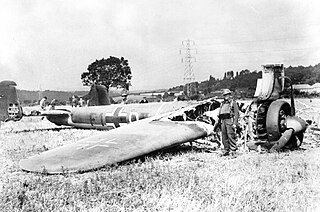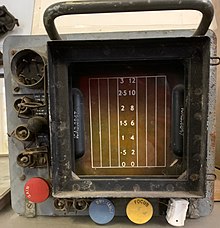
The Avro Lancaster is a British Second World War heavy bomber. It was designed and manufactured by Avro as a contemporary of the Handley Page Halifax, both bombers having been developed to the same specification, as well as the Short Stirling, all three aircraft being four-engined heavy bombers adopted by the Royal Air Force (RAF) during the same era.

A heavy fighter is a historic category of fighter aircraft produced in the 1930s and 1940s, designed to carry heavier weapons or operate at longer ranges than light fighter aircraft. To achieve performance, most heavy fighters were twin-engine, and many had multi-place crews; this was in contrast to light fighters, which were typically single-engine and single-crew aircraft. In Germany, these larger fighters were known as Zerstörer ("destroyer").

A night fighter is a fighter aircraft adapted for use at night or in other times of bad visibility. Night fighters began to be used in World War I and included types that were specifically modified to operate at night.

Schräge Musik, which may also be spelled Schraege Musik, was a common name for the fitting of an upward-firing autocannon or machine gun, to an interceptor aircraft, such as a night fighter. The term was introduced by the German Luftwaffe during World War II. "Schräge Musik" was previously a German colloquialism, meaning music that featured an unusual tuning and/or time signature. The standard usage of the adjective schräg is often translated as "slanting" or "oblique", but its slang usage is often translated as "weird" or "strange".

The Messerschmitt Bf 110, often known unofficially as the Me 110, is a twin-engined Zerstörer, fighter-bomber, and night fighter (Nachtjäger) developed in Nazi Germany in the 1930s and used by the Luftwaffe during World War II. Hermann Göring was a proponent of the Bf 110, believing its heavy armament, speed, and range would make the Bf 110 the Luftwaffe’s premier offensive fighter. Early variants were armed with two MG FF 20 mm cannon, four 7.92 mm MG 17 machine guns, and one 7.92 mm MG 15 machine gun for defence. Development work on an improved type to replace the Bf 110 - the Messerschmitt Me 210 - began before the war started, but its shakedown troubles resulted in the Bf 110 soldiering on until the end of the war in various roles. Its intended replacements, the aforementioned Me 210 and the significantly improved Me 410 Hornisse, never fully replaced the Bf 110.

The Naxos radar warning receiver was a World War II German countermeasure to S band microwave radar produced by a cavity magnetron. Introduced in September 1943, it replaced Metox, which was incapable of detecting centimetric radar. Two versions were widely used, the FuG 350 Naxos Z that allowed night fighters to home in on H2S radars carried by RAF Bomber Command aircraft, and the FuMB 7 Naxos U for U-boats, offering early warning of the approach of RAF Coastal Command patrol aircraft equipped with ASV Mark III radar. A later model, Naxos ZR, provided warning of the approach of RAF night fighters equipped with AI Mk. VIII radar.

The Lichtenstein radar was among the earliest airborne radars available to the Luftwaffe in World War II and the first one used exclusively for air interception. Developed by Telefunken, it was available in at least four major revisions, called FuG 202 Lichtenstein B/C, FuG 212 Lichtenstein C-1, FuG 220 Lichtenstein SN-2 and the very rarely used FuG 228 Lichtenstein SN-3.. The Lichtenstein series remained the only widely deployed airborne interception radar used by the Germans on their night fighters during the war — the competing FuG 216 through 218 Neptun mid-VHF band radar systems were meant as a potentially more versatile stop-gap system through 1944, until the microwave-based FuG 240 "Berlin" could be mass-produced; the Berlin system was still being tested when the war ended.
The FuG 227 Flensburg was a German passive radar receiver developed by Siemens & Halske and introduced into service in early 1944. It used wing and tail-mounted dipole antennae and was sensitive to the mid-VHF band frequencies of 170–220 MHz, subharmonics of the Monica radar's 300 MHz transmissions. It allowed Luftwaffe nightfighters to home in on the Monica tail warning radar fitted to RAF bombers.

The Kammhuber Line was the Allied name given to the German night air defense system established in July 1940 by Colonel Josef Kammhuber. It consisted of a series of control sectors equipped with radars and searchlights and an associated night fighter. Each sector would direct the night fighter into visual range with target bombers.
Serrate was a World War II Allied radar detection and homing device used by night fighters to track Luftwaffe night fighters equipped with the earlier UHF-band BC and C-1 versions of the Lichtenstein radar. It allowed RAF night fighters to attack their German counterparts, disrupting their attempts to attack the RAF's bomber force.

Martin Drewes was a German Luftwaffe military aviator and night fighter ace during World War II. He was credited with 52 victories of which 43 were claimed at night whilst flying variants of the Messerschmitt Bf 110 heavy fighter. The majority of his victories were claimed over the Western Front in Defence of the Reich missions against the Royal Air Force's Bomber Command.

The Defence of the Reich is the name given to the strategic defensive aerial campaign fought by the Luftwaffe of Nazi Germany over German-occupied Europe and Germany during World War II. Its aim was to prevent the destruction of German civilians, military and civil industries by the Western Allies. The day and night air battles over Germany during the war involved thousands of aircraft, units and aerial engagements to counter the Allied strategic bombing campaign. The campaign was one of the longest in the history of aerial warfare and with the Battle of the Atlantic and the Allied Blockade of Germany was the longest of the war. The Luftwaffe fighter force defended the airspace of German-occupied territory against attack, first by RAF Bomber Command and then against the United States Army Air Forces (USAAF) in the Combined Bomber Offensive.
Nachtjagdgeschwader 1 (NJG 1) was a German Luftwaffe night fighter-wing of World War II. NJG 1 was formed on 22 June 1940 and comprised four Gruppen (groups). NJG 1 was created as an air defence unit for the Defence of the Reich campaign; an aerial war waged by the Luftwaffe against the bombing of the German Reich by RAF Bomber Command and the United States Air Force. In 1941 airborne radar was introduced with radar operators, and standardised in 1942 and 1943. Consequently, a large number of German night fighter aces existed within NJG 1.
Nachtjagdgeschwader 2 was a German Luftwaffe night fighter and night intruder wing during World War II.

Reinhold Eckardt was a night fighter pilot in the Luftwaffe of Nazi Germany during World War II. He was a recipient of the Knight's Cross of the Iron Cross during World War II. Eckardt died on 30 July 1942 after his parachute caught the end of his plane after he bailed out. During his career he was credited with 22 aerial victories, 3 during the day and 19 at night.

August Geiger was a German Luftwaffe military aviator during World War II, a night fighter ace credited with 53 aerial victories making him the nineteenth most successful night fighter pilot in the history of aerial warfare. All of his victories were claimed over the Western Front in Defense of the Reich missions, the majority at night against the Royal Air Force's (RAF) Bomber Command and one daytime claim over a United States Army Air Forces (USAAF) Boeing B-17 Flying Fortress.

The Hardest Day was a Second World War air battle fought on 18 August 1940 during the Battle of Britain between the German Luftwaffe and British Royal Air Force (RAF). On that day, the Luftwaffe made an all-out effort to destroy RAF Fighter Command. The air battles that took place on that day were amongst the largest aerial engagements in history to that time. Both sides suffered heavy losses. In the air, the British shot down twice as many Luftwaffe aircraft as they lost. However, many RAF aircraft were destroyed on the ground, equalising the total losses of both sides. Further large and costly aerial battles took place after 18 August, but both sides lost more aircraft combined on this day than at any other point during the campaign, including 15 September, the Battle of Britain Day, generally considered the climax of the fighting. For this reason, Sunday 18 August 1940 became known as "the Hardest Day" in Britain.
A tail warning radar, sometimes TW for short, was a short-lived class of aircraft-mounted radar systems used to provide warning of another aircraft approaching from the rear.
German Luftwaffe and Kriegsmarine Radar Equipment during World War II, relied on an increasingly diverse array of communications, IFF and RDF equipment for its function. Most of this equipment received the generic prefix FuG, meaning "radio equipment". During the war, Germany renumbered their radars. From using the year of introduction as their number they moved to a different numbering scheme.













